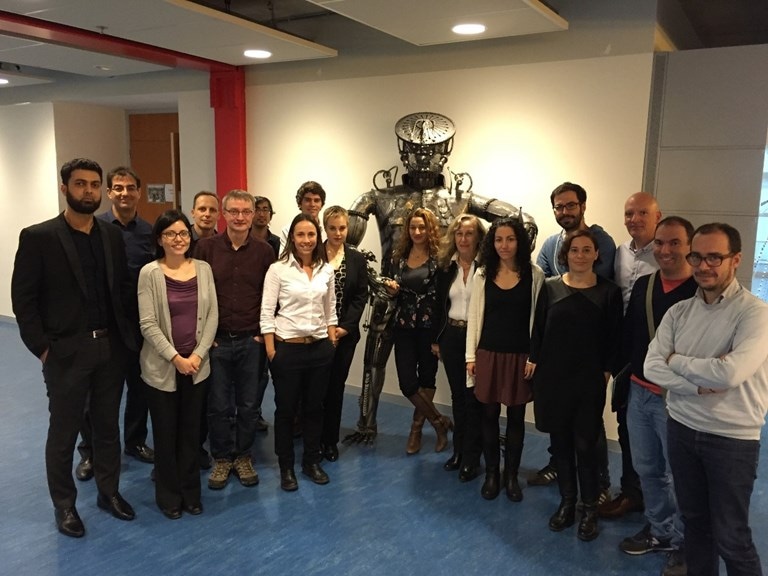Dec 5 2019
Scientists have successfully detected trace levels of a cancer protein biomarker in a urine sample using a chip-based sensor with a built-in laser. The study is the first to achieve this breakthrough.
 GLAM project team during the project meeting at the University of Twente. Image Credit: Sonia M. Garcia-Blanco, University of Twente.
GLAM project team during the project meeting at the University of Twente. Image Credit: Sonia M. Garcia-Blanco, University of Twente.
Compared to other designs, the novel technology is more sensitive and may result in cost-effective and non-invasive techniques to identify molecules indicating the progression or presence of a specific disease.
Current methods to measure biomarker levels are expensive and sophisticated, requiring biopsies and analysis in specialized laboratories. The new technology we developed paves the way to faster and ultra-sensitive detection of panels of biomarkers that will permit doctors to make timely decisions that improve personalized diagnosis and treatment of medical conditions including cancer.
Sonia M. Garcia-Blanco, Research Team Leader, University of Twente
A multi-institutional research team has demonstrated that the novel sensor can carry out label-free detection of a specific protein called S100A4. This protein is linked with the development of human tumors at clinically relevant levels.
The researchers were financially supported by the H2020 European project GLAM (Glass multiplexed biosensor). The study has been published in Optics Letters, The Optical Society (OSA) journal.
“The biosensor could enable point-of-care devices that simultaneously screen for various diseases,” added Garcia-Blanco. “Its operation is simple and does not require complicated sample treatments or sensor operation, making it an excellent candidate for clinical applications.”
According to the scientists, the new sensor also shows promise for non-biomedical applications. For instance, the sensor can be used for detecting different types of liquid or gas mixtures.
Creating a High-Sensitivity Sensor
Specific molecules are detected by the new chip-based sensor, wherein an on-chip microdisk laser emits light that illuminates the sample. When an interaction occurs between the light and the target biomarker, there is a detectable shift in the frequency or color of the laser light.
To detect the biomarkers in urine samples, the scientists had to find a way to incorporate a laser that can work in a liquid setting. The team eventually used the photonic material aluminum oxide, because doping this compound with ytterbium ions helps create a laser. Such a laser produces light in a wavelength range that is beyond the water’s light absorption band and still allows the accurate detection of biomarkers in urine samples.
Although sensors based on monitoring frequency shifts of lasers already exist, they often come in geometries that are not easily integrated on small, disposable photonic chips. Aluminum oxide can easily be fabricated monolithically on-chip and is compatible with standard electronic fabrication procedures. This means that the sensors can be produced on a large, industrial scale.
Sonia M. Garcia-Blanco, Research Team Leader, University of Twente
Instead of using the non-lasing ring resonators typically employed in other analogous sensors, a microdisk laser paves the way to unmatched sensitivity. Such sensitivity can be attributed to the fact that the lasing linewidth is relatively narrower when compared to the resonances of passive ring resonators.
When thermal noise and other noise sources are removed, this technique will help detect extremely small frequency shifts from biomarkers at trace concentrations.
Detecting Minute Biomarker Concentrations
Initially, the scientists developed and applied a surface treatment that captures the target biomarkers in complex liquids, like urine. Then, they tested the novel sensor with artificial urine that contained known levels of biomarkers. The researchers successfully detected the S100A4 protein at very low concentrations of 300 picomolar.
Detection in this concentration range shows the potential of the platform for label-free biosensing. Furthermore, the detection module can be potentially made very simple using the developed technology, bringing it a step closer to the final application outside of the laboratory.
Sonia M. Garcia-Blanco, Research Team Leader, University of Twente
The scientists are currently exploring ways to integrate all the applicable signal generation components and optical sources onto the chip-based sensor, so that it can be operated more easily. They are also planning to create a variety of coatings that would allow a large range of biomarkers to be detected in parallel.